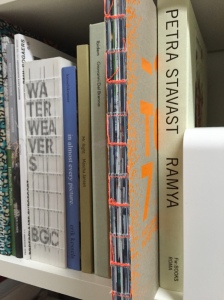About different ways of binding
Traditionally a book comes in two varieties.
The oldest and most luxurious one is the hard cover book.
All pages are formed into a book block that forms a unity in itself and that is fixed to the case.
The other variety is the paperback.
The inside pages are directly glued to the spine of the cover, which is made of thicker paper.
Folding pages into sections and sewing those sections together is the firmest way to make a book.
You can then choose to glue the so formed book directly to the spine of a thicker paper to make a soft cover book
Or you attach endpapers on the first and last page, glue a stripe of shirting on the spine to mould the spine firmly and glue the endpapers to a case, forming a hard cover book.
You can also forget about sewing and glue the pages after ruffing them, together and make either a hard or a soft cover book.
The latter is called perfect binding and is cheaper but less durable, no doubt.
And now there is Otabind, Otapur or variations on the theme.
Here the spine of the book is no longer attached to the spine of the soft cover.
The book block is attached to the inside of the cover, leaving a smooth and flexible spine.
Depending on which type of glue has been used the book will open pretty much as a hard cover.
Even a perfect bound book, glued in PUR will open up reasonably and will last forever.

